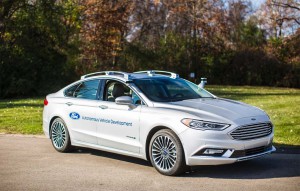Ford Motor Co. will invest $1 billion over the next five years to take a controlling stake in an artificial intelligence start-up in its bid to bring driverless vehicles to market by 2021.
Pittsburgh-based Argo AI was launched only last November by two autonomous vehicle veterans from Google and Uber. Argo will now take over the software side of Ford’s driverless vehicle research program, though the automaker will continue to control the hardware side of that project.
“As Ford expands to be an auto and a mobility company, we believe that investing in Argo AI will create significant value for our shareholders by strengthening Ford’s leadership in bringing self-driving vehicles to market in the near term and by creating technology that could be licensed to others in the future,” said Ford CEO Mark Fields during a conference call with analysts and reporters.
(Ford reveals plans to dive deeper into mobility alternatives. Click Here to see what it’s working on.)
What Fields described as a “hybrid” business model means Argo will be listed as a Ford subsidiary on the Detroit automaker’s books. But while Ford will gain a controlling, albeit unspecified, stake in Argo, a “significant” stake will be retained by its two founders and then used as a recruitment and retention tool for talent.
“There’s a war for talent” in the artificial intelligence and robotic areas, noted Fields.
Argo was founded by Bryan Salesky, a veteran of the autonomous vehicle program at Google – which recently was renamed Waymo. Salesky will continue to serve as Argo’s CEO alongside COO Peter Rander, who was a member of the autonomous team at ride-sharing service Uber until last September.
Salesky said the two partners specifically aimed to form a partnership with a major automaker when they formed Argo last autumn, seeing that as a way to both raise the necessary capital and develop the necessary scale for their technology once it becomes ready for market.
For its part, Ford last year announced it would target bringing out a so-called Level 4 self-driving vehicle by 2021. Such a vehicle would be able to operate without a driver in most, though not all, weather and road conditions. Other manufacturers are targeting different levels of autonomy.
But there remains much debate over the progress being made in self-driving vehicles. Some manufacturers, notably including Nissan and Tesla, hope to have their own products to market by the end of this decade. Some skeptics question whether the industry will be able to get there in any form before the middle to late 2020s. So, any potential advantage in bringing the technology to market is seen as a highly valuable advantage.

Peter Rander, Argo AI COO; Mark Fields, Ford president and CEO; Bryan Salesky, Argo AI CEO; and Raj Nair, Ford Product Development chief.
Manufacturers are, in turn, taking a variety of different approaches. Some are working entirely in-house. Others are counting on purchasing autonomous systems from suppliers such as Continental, or from tech firms like Google. Both Honda and Fiat Chrysler have formed relationships with Google in recent months.
Still other manufacturers are reaching outside to swallow up start-ups that might have an edge over their own research programs. General Motors last year announced it would spend $1 billion to acquire San Francisco-based Cruise Automation. Cruise now operates as a wholly owned subsidiary but has been given a significant degree of freedom from GM.
According to the new partners, Ford will also keep Argo at arm’s length, though it will have two members on that company’s board. The two founders will each have a seat, and an outside director will also be added.
“We see this as a faster path to market” with autonomous vehicle technology, said Salesky.
(GM exploring options for more battery-electric vehicles. Click Here for the story.)
Fields said Ford sees a number of ways to benefit, long-term, from the new deal. Not only does it hope to speed up its autonomous vehicle research and development program, but it believes it could also sell the eventual technology to some of its competitors. It is also considering other options that could eventually include staging an IPO for Argo.
Ford will continue to work with other partners on its autonomous efforts, that includes China’s tech firm Baidu. Together, they agreed last year to invest $150 million in Velodyne, considered a leader in the development of LIDAR, a high-definition 3D, laser-imaging technology. Along with radar, sonar and artificial vision systems LIDAR is considered by most experts to be an essential part of the so-called “sensor fusion” that will be needed to make more advanced versions of autonomous driving possible.
For its part, Waymo recently began developing its own LIDAR system and other sensor technologies. That Google unit’s CEO John Krafcik said last month that it has been able to drop the price of a LIDAR scanner tenfold, from around $70,000 to $7,000. But experts warn that the price of autonomous sensors must came down several more orders of magnitude to be within reach of everyday drivers. And that doesn’t even take into account the need to further refine the controlling software. For Ford, that’s where Argo now becomes essential.
(Electrifying design: Click Here to learn how electric propulsion and autonomous driving will transform the way vehicles look, inside and out.)


